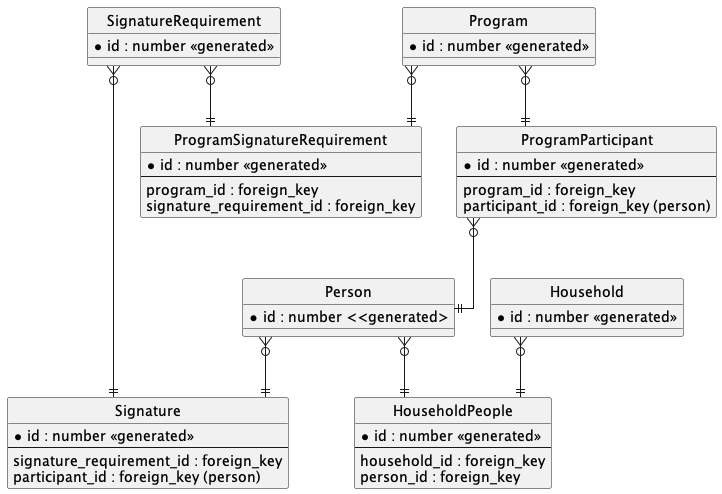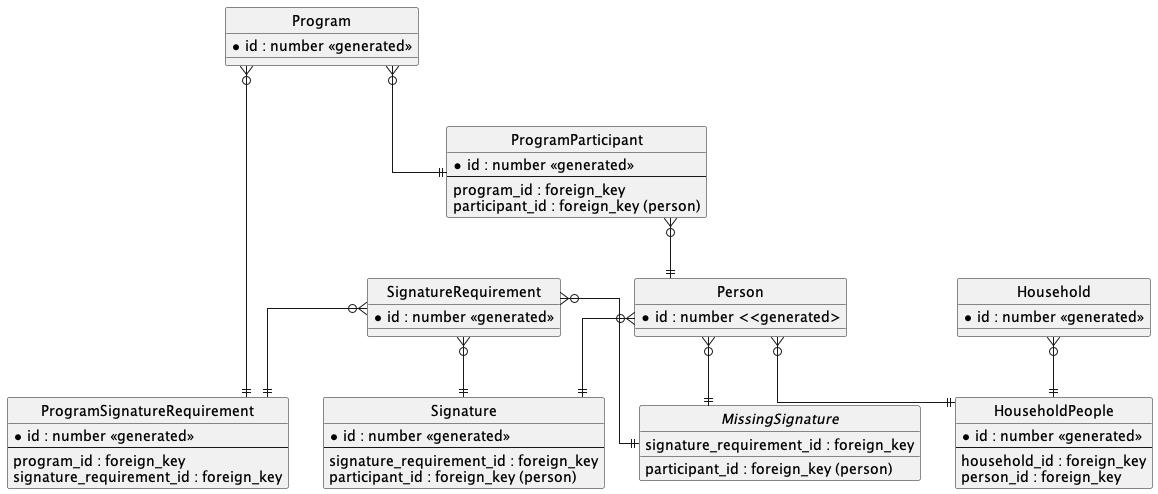Abstractions With Database Views
Wikipedia defines a software abstraction as:
In software engineering and computer science, abstraction is… the process of removing physical, spatial, or temporal details or attributes in the study of objects or systems to focus attention on details of greater importance; it is similar in nature to the process of generalization;
A database view can provide a useful abstraction; a concept that represents something in a domain. Recently, I had the opportunity to do use a view to create an abstraction, to represent data that is missing from the database.
I’m working on a system that tracks program participation for a community center. The relevant characteristic here are:
- Each program can have many participant.
- Programs can also have signature requirements: They are digital agreement that participants “sign”. They can’t participate in the program without them.
- It’s important for the community center staff to track the signatures, and which participants have not fulfilled the requirements. Several programs can share the same signature requirement (e.g. a code of conduct).
- Participants only need to sign each requirement once.
- Participants belongs to households.
- Adults in households can sign on behalf of minor participants.

The accompanying Rails1 models are relatively straight forward:
class Person < ApplicationRecord
has_many :household_people
has_many :household
has_many :program_participants
has_many :participants, through: :program_participants
end
class Household < ApplicationRecord
has_many :household_people
has_many :people, through: :household_people
end
class HouseholdPerson < ApplicationRecord
belongs_to :household
belongs_to :person
end
class Program < ApplicationRecord
has_many :program_participants
has_many :participants, through: :program_participants
has_many :program_signature_requirements
has_many :signature_requirements, through: :program_signature_requirements
end
class ProgramParticipant < ApplicationRecord
belongs_to :program
belongs_to :participant, class_name: "Person"
end
class SignatureRequirement < ApplicationRecord
has_many :program_signature_requirements
has_many :signatures
end
class ProgramSignatureRequirement < ApplicationRecord
belongs_to :signature_requirement
belongs_to :program
end
class Signature < ApplicationRecord
belongs_to :signature_requirement
belongs_to :participant
end
The relationships fit well with Rails’ associations, taking advantage of a few join tables (e.g. household_people, program_participants, program_signature_requirements). The basic user experience (UX) for administrators managing data in the system followed typical CRUD; It became more complex when creating the UX for participants.
Finding Pending Requirements
To create the simplest experience possible for parents of program participants, we settled on the following UX:
- A parent is shown a list of pending requirements: This is a list documents the have to (electronically) sign. A pending requirements is one that is associated with a program that at least one user in the household is a participant of. It must also not have been met.
- Once the parent selects the requirements to sign, he can do so with a single submission on behalf of any of the children in the same household, that don’t yet have a signature for that requirements.
Inspection of the data modeling reveals that both queries – pending requirements and eligible participant signatures for a household – are possible with a single roundtrip (SQL statement) from the database. The query is not trivial. It must join, household, household_people, programs, program_participants, signature_requirements and program_signature_requirements to obtain the set of signature that we want to exist at some point. We also require removing from those list those signatures that already exist. The removal portion suggest to me using a LEFT JOIN to the signatures table, and filtering WHERE signatures.id IS NULL to remove the existing signatures from the set.
I tried writing the queries using ActiveRecord in several ways, using joins and sub-selects. I found myself getting results that were not quite correct and having a hard time reasoning about it. The cognitive load of keeping that many things in my head at once was getting the best of me. Fortunately, I recognize the thought pattern, and more importantly the solution: What can I abstract away to make it easier?
Eventually I settled on MissingSignature: It represents the domain concept of some data that we want to exist, but doesn’t. I know of two ways to create data abstraction in relational databases: Common Table Expressions (CTEs) and database views. Both are supported to a certain extent in Ruby on Rails. CTEs are supported through the use of arel, which is not considered public API. It can be awkward to mix and with regular ActiveRecord queries. Views on the other hand, are mostly treated by Rails as tables. That allows us to abstract away how the are defined. With the help of the scenic gem, defining a view is simple.
-- db/views/missing_signatures_v01.sql
WITH current_participant_requirements AS (
SELECT
"program_signature_requirements"."signature_requirement_id",
"program_participants"."participant_id"
FROM
"program_participants"
INNER JOIN "program_signature_requirements" ON "program_signature_requirements"."program_id" = "program_participants"."program_id"
INNER JOIN "programs" ON "programs"."id" = "program_signature_requirements"."program_id"
AND "programs"."id" = "program_participants"."program_id"
INNER JOIN "signature_requirements" ON "signature_requirements"."id" = "program_signature_requirements"."signature_requirement_id"
WHERE
"signature_requirements"."expires_at" >= now())
SELECT
cpr.*
FROM
"current_participant_requirements" cpr
LEFT JOIN "signatures" ON "signatures"."participant_id" = "cpr"."participant_id"
AND "signatures"."signature_requirement_id" = "cpr"."signature_requirement_id"
WHERE
"signatures"."id" IS NULL
The above SQL is the source for the missing_signatures view. Within that view, there is a CTE for current_participant_requirements which does the heavy lifting in terms of joins, and also filters to “current” requirements. We don’t care for requirements that have expired, since the don’t need to be signed anymore. The CTE makes is easy to split the logic between finding the correct requirements, and then only showing the “pending” ones, via the LEFT JOIN ... WHERE signatures.id IS NULL.
With the view in hand, using it in Rails is straightforward:
class MissingSignature < ApplicationRecord
belongs_to :signature_requirement
belongs_to :participant, class_name: "Person"
def read_only?
true
end
end
The ready_only? prevents ActiveRecord from attempting to write to that view, which would fail anyway. Notice that it can take advantage of regular ActiveRecord associations, on both sides:
class SignatureRequirements < ApplicationRecord
# ...
has_many :missing_signatures
end
class Person < ApplicationRecord
# ...
has_many :missing_signatures, inverse_of: :participant, foreign_key: :participant_id
end
The resulting ERD diagram, illustrates the relationships:

Simplified Queries
With our new abstraction in place, the once-complicated queries can now be expressed with regular joins:
# Pending Requirements
SignatureRequirement
.joins(:missing_signatures, programs: {program_participants: :participant})
.merge(household.people)
.distinct
# Possible Participants
Person
.joins(:household_people, :missing_signatures)
.merge(household.people)
.merge(MissingSignature.where(signature_requirement_id: signature_requirement.id))
.distinct
Each of the above generates a single SQL statement. The first looks like:
SELECT DISTINCT
"signature_requirements".*
FROM
"signature_requirements"
INNER JOIN "missing_signatures" ON "missing_signatures"."signature_requirement_id" = "signature_requirements"."id"
INNER JOIN "program_signature_requirements" ON "program_signature_requirements"."signature_requirement_id" = "signature_requirements"."id"
INNER JOIN "programs" ON "programs"."id" = "program_signature_requirements"."program_id"
INNER JOIN "program_participants" ON "program_participants"."program_id" = "programs"."id"
INNER JOIN "people" ON "people"."id" = "program_participants"."participant_id"
INNER JOIN "household_people" ON "people"."id" = "household_people"."person_id"
WHERE
"household_people"."household_id" = 253
Without the abstraction, a query that generates the same results, would be possible, but considerably more complex. It would require joining on the same tables multiple times.
Conclusion
A software abstraction provides more than indirection. It provides a way to reduce cognitive load. It simplifies by allowing us to not think about all the details at once. In this example, the domain concept the that was abstracted represents data that has not been written to the database; data that is missing. A database view provided a convenient way to integrate to the rest of the tooling.
-
Code examples target Ruby on Rails 6.0, using PostgreSQL. Other database engines also support views, but I haven’t tried them. ↩
Find me on:
- Bluesky at @ylan.segal.family.com
- Mastodon at @ylansegal@mastodon.sdf.org
- By email at
ylan@{this top domain}